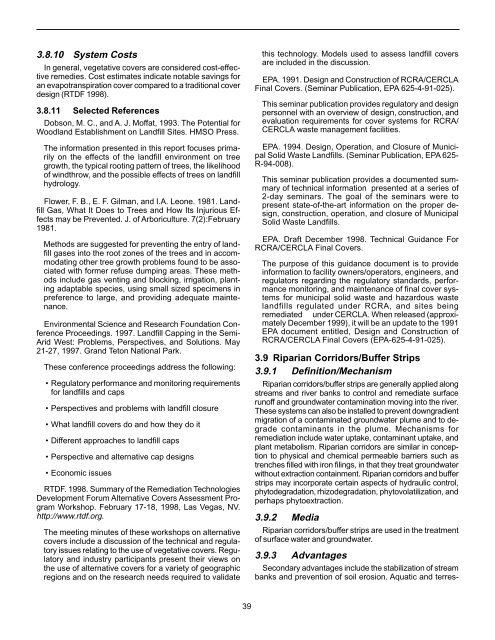Introduction to Phytoremediation - CLU-IN
Introduction to Phytoremediation - CLU-IN
Introduction to Phytoremediation - CLU-IN
You also want an ePaper? Increase the reach of your titles
YUMPU automatically turns print PDFs into web optimized ePapers that Google loves.
3.8.10 System Costs<br />
In general, vegetative covers are considered cost-effective<br />
remedies. Cost estimates indicate notable savings for<br />
an evapotranspiration cover compared <strong>to</strong> a traditional cover<br />
design (RTDF 1998).<br />
3.8.11 Selected References<br />
Dobson, M. C., and A. J. Moffat, 1993. The Potential for<br />
Woodland Establishment on Landfill Sites. HMSO Press.<br />
The information presented in this report focuses primarily<br />
on the effects of the landfill environment on tree<br />
growth, the typical rooting pattern of trees, the likelihood<br />
of windthrow, and the possible effects of trees on landfill<br />
hydrology.<br />
Flower, F. B., E. F. Gilman, and I.A. Leone. 1981. Landfill<br />
Gas, What It Does <strong>to</strong> Trees and How Its Injurious Effects<br />
may be Prevented. J. of Arboriculture. 7(2):February<br />
1981.<br />
Methods are suggested for preventing the entry of landfill<br />
gases in<strong>to</strong> the root zones of the trees and in accommodating<br />
other tree growth problems found <strong>to</strong> be associated<br />
with former refuse dumping areas. These methods<br />
include gas venting and blocking, irrigation, planting<br />
adaptable species, using small sized specimens in<br />
preference <strong>to</strong> large, and providing adequate maintenance.<br />
Environmental Science and Research Foundation Conference<br />
Proceedings. 1997. Landfill Capping in the Semi-<br />
Arid West: Problems, Perspectives, and Solutions. May<br />
21-27, 1997. Grand Te<strong>to</strong>n National Park.<br />
These conference proceedings address the following:<br />
• Regula<strong>to</strong>ry performance and moni<strong>to</strong>ring requirements<br />
for landfills and caps<br />
• Perspectives and problems with landfill closure<br />
• What landfill covers do and how they do it<br />
• Different approaches <strong>to</strong> landfill caps<br />
• Perspective and alternative cap designs<br />
• Economic issues<br />
RTDF. 1998. Summary of the Remediation Technologies<br />
Development Forum Alternative Covers Assessment Program<br />
Workshop. February 17-18, 1998, Las Vegas, NV.<br />
http://www.rtdf.org.<br />
The meeting minutes of these workshops on alternative<br />
covers include a discussion of the technical and regula<strong>to</strong>ry<br />
issues relating <strong>to</strong> the use of vegetative covers. Regula<strong>to</strong>ry<br />
and industry participants present their views on<br />
the use of alternative covers for a variety of geographic<br />
regions and on the research needs required <strong>to</strong> validate<br />
39<br />
this technology. Models used <strong>to</strong> assess landfill covers<br />
are included in the discussion.<br />
EPA. 1991. Design and Construction of RCRA/CERCLA<br />
Final Covers. (Seminar Publication, EPA 625-4-91-025).<br />
This seminar publication provides regula<strong>to</strong>ry and design<br />
personnel with an overview of design, construction, and<br />
evaluation requirements for cover systems for RCRA/<br />
CERCLA waste management facilities.<br />
EPA. 1994. Design, Operation, and Closure of Municipal<br />
Solid Waste Landfills. (Seminar Publication, EPA 625-<br />
R-94-008).<br />
This seminar publication provides a documented summary<br />
of technical information presented at a series of<br />
2-day seminars. The goal of the seminars were <strong>to</strong><br />
present state-of-the-art information on the proper design,<br />
construction, operation, and closure of Municipal<br />
Solid Waste Landfills.<br />
EPA. Draft December 1998. Technical Guidance For<br />
RCRA/CERCLA Final Covers.<br />
The purpose of this guidance document is <strong>to</strong> provide<br />
information <strong>to</strong> facility owners/opera<strong>to</strong>rs, engineers, and<br />
regula<strong>to</strong>rs regarding the regula<strong>to</strong>ry standards, performance<br />
moni<strong>to</strong>ring, and maintenance of final cover systems<br />
for municipal solid waste and hazardous waste<br />
landfills regulated under RCRA, and sites being<br />
remediated under CERCLA. When released (approximately<br />
December 1999), it will be an update <strong>to</strong> the 1991<br />
EPA document entitled, Design and Construction of<br />
RCRA/CERCLA Final Covers (EPA-625-4-91-025).<br />
3.9 Riparian Corridors/Buffer Strips<br />
3.9.1 Definition/Mechanism<br />
Riparian corridors/buffer strips are generally applied along<br />
streams and river banks <strong>to</strong> control and remediate surface<br />
runoff and groundwater contamination moving in<strong>to</strong> the river.<br />
These systems can also be installed <strong>to</strong> prevent downgradient<br />
migration of a contaminated groundwater plume and <strong>to</strong> degrade<br />
contaminants in the plume. Mechanisms for<br />
remediation include water uptake, contaminant uptake, and<br />
plant metabolism. Riparian corridors are similar in conception<br />
<strong>to</strong> physical and chemical permeable barriers such as<br />
trenches filled with iron filings, in that they treat groundwater<br />
without extraction containment. Riparian corridors and buffer<br />
strips may incorporate certain aspects of hydraulic control,<br />
phy<strong>to</strong>degradation, rhizodegradation, phy<strong>to</strong>volatilization, and<br />
perhaps phy<strong>to</strong>extraction.<br />
3.9.2 Media<br />
Riparian corridors/buffer strips are used in the treatment<br />
of surface water and groundwater.<br />
3.9.3 Advantages<br />
Secondary advantages include the stabilization of stream<br />
banks and prevention of soil erosion. Aquatic and terres-
















